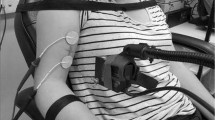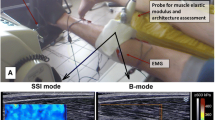Abstract
Our laboratory has shown that resting muscle, commonly thought to be mechanically inert, is actually mechanically active. We report a study of the mechanics of resting quadriceps muscle in adult surgical patients that determines how much metabolic activity can be attributed to quadriceps resting-muscle mechanical work. This was calculated by studying the motion of relaxed supine subjects’ instrumented legs dropped onto a pillow before and after anesthesia with muscle paralysis. By subtracting the acceleration of the dropping leg of the conscious subject before the quadriceps is paralysed from that found after paralysis, resting muscle tensile force and power of the quadriceps muscles can be calculated. Mechanomyography was also recorded, using an accelerometer. Paralysis produced an increase in acceleration in all cases (pre-paralysis 6.99 ± 1.51 m s−2; post-paralysis 7.65 ± 1.51 m s−2; P = 0.00007) and a decrease in mechanomyographic mean absolute amplitude (pre-paralysis 10.6 ± 3.7 mm s−2; post-paralysis 4.5 ± 2.6 mm s−2; P = 0.00003). Calculated force exerted by resting quadriceps was 22.6 ± 16.8 N; power 0.34 ± 0.17 W, corresponding to a daily caloric expenditure of 7.0 ± 3.6 kcal day−1. This corresponds to approximately 205 kcal day−1 for all skeletal muscle. Knowledge of the phenomenon of resting muscle mechanical activity may be of clinically importance in the study and treatment of obesity and of disorders of muscle tone.



Similar content being viewed by others
References
Birmingham CL, Jones PJ (2002) Clinical nutrition: 5. How much should Canadians eat? CMAJ 166:767–770
Clarys JP et al (1999) Human body composition: a review of adult dissection data. Am J Human Biol 11:167–174
deVries HA (1965) Muscle tonus in postural muscles. Am J Physical Med 44:275–291
deVries HA, Burke RK, Hopper RT, Sloan JH (1976) Relationship of resting EMG level to total body metabolism with reference to the origin of “tissue noise”. Am J Phys Med 55:139–147
Fee JW Jr, Miller F (2004) The leg drop pendulum test performed under general anesthesia in spastic cerebral palsy. Dev Med Child Neurol 46:273–281
Guyton AC, Hall JE (2001) Textbook of medical physiology, 10th edn. WB Saunders Company, Philadelphia, p 626
Hsu AT, Perry J, Gronley JK, Hislop HJ (1993) Quadriceps force and myoelectric activity during flexed knee stance. Clin Orthop Relat Res 288:254–262
Jacobson E (1943) Innervation and tonus of striated muscle in man. J Nerv Ment Dis 97:197–203
Jacobson E (1951) Muscular tension and the estimation of effort. Am J Psychol 64:112–124
Kamen G, Koceja DM (1989) Contralateral influences on patellar tendon reflexes in young and old adults. Neurobiol Aging 10:311–315
McKay WP, Gregson PH, McKay BW, Blanchet T (1998) Resting muscle sounds in anesthetized patients. Can J Physiol Pharmacol 76:401–406
McKay WP, Chilibeck PD, Chad KE, Daku BL (2004) Resting mechanomyography after aerobic exercise. Can J Appl Physiol 29:743–757
McKay WP, Jacobson P, Chilibeck PD, Daku BL (2006) Effects of graded levels of exercise on ipsilateral and contralateral post-exercise resting rectus femoris mechanomyography. Eur J Appl Physiol 98:566–574
McKay WP, Lett B, Chilibeck PD, Daku BL (2009) Effects of spinal anesthesia on resting metabolic rate and quadriceps mechanomyography. Eur J Appl Physiol 106:583–588
Oster G (1984) Muscle sounds. Sci Am 250:108–114
Proske U, Morgan DL (1999) Do cross-bridges contribute to the tension during stretch of passive muscle? J Muscle Res Cell Motil 20:433–442
Rohracher H (1959) Staendige Muskelaktivitaet (Mikrovibration), Tonus und Konstanz der Korpertemperatur. Z f Biol 111:38–53
Rohracher H (1962) Permanente rhythmische Mikrobewegungen des Warmbluter-Organismus “Mikrovibration” (review; German only). Die Naturwissenschaften 49:145–150
Sugano H (1960) Studies on minor tremor. Japanese J Physiol 10:246–257
Tate CMWG (2006) Lower extremity muscle morphology in young athletes: an MRI-based analysis. Med Sci Sports Exerc 38:122–128
Ward AB (2000) Assessment of muscle tone. Age Ageing 29:385–386
Wartenberg R (1951) Pendulousness of the legs as a diagnostic test. Neurology 1:18–24
Author information
Authors and Affiliations
Corresponding author
Additional information
Communicated by Roberto Bottinelli.
Rights and permissions
About this article
Cite this article
Mckay, W.P., Chilibeck, P.D., Daku, B.L.F. et al. Quantifying the mechanical work of resting quadriceps muscle tone. Eur J Appl Physiol 108, 641–648 (2010). https://doi.org/10.1007/s00421-009-1261-9
Accepted:
Published:
Issue Date:
DOI: https://doi.org/10.1007/s00421-009-1261-9




